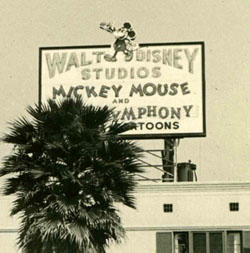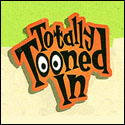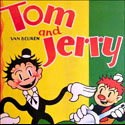 Cartoon Research regular columnist Jim Korkis has authored a new book for Theme Park Press entitled Who’s the Leader of the Club? Walt Disney’s Leadership Lessons.
Cartoon Research regular columnist Jim Korkis has authored a new book for Theme Park Press entitled Who’s the Leader of the Club? Walt Disney’s Leadership Lessons.
While the book contains plenty of Jim’s trademarks – out-of-the-ordinary quotes from Walt Disney and the people with whom he worked, as well as some great behind-the-scenes stories – this book is different from Jim’s other books because it also serves as an informative workbook on Walt’s leadership techniques and how they can be applied to leaders and businesses.
With all the recent controversies over Disney’s current leadership – it’s great to hear what Walt himself had to say. I did this friendly little Q&A with Jim to learn more about this book and why Jim decided to compile it.
Jerry: Jim, let’s talk about your new book. It is something I don’t think most of your fans expected from you.
Jim: Probably not which is why I am thankful you are doing this interview so people can understand a little more about it. There are a ton of books out there, even from Disney itself, about how Disney runs it business when it comes to things like customer service. However, there is not one book about how Walt ran his business with Roy. They are the ones who set the foundations that have gradually shifted over the years with different administrations.
Jerry: Yes, Walt came up with the ideas and his older brother Roy had to find the money for them.
Jim: Actually, when people read the book, they will find that is not entirely accurate although all of us have believed that for decades. Walt never flew off to Neverland without knowing exactly where he was going. He had a healthy respect for money and budgets but he never felt confined by them. Roy not only managed the money but help set the tone of how the business was run. His contributions are extremely underrated.
Jerry: I notice you gave Roy his own chapter to point out some of those manager skills.
 Jim: I divided the book into three sections. In the first section, I talk about leaders and managers using Walt and Roy as examples and including a lot of interview material from people who worked directly with them. The second section is a series of seven lessons based on good leadership techniques that Walt used and how people can adapt them to their leadership style whether they are a coach of a Little League team, run a hospital or own a small business. Finally, the third section is devoted to miscellaneous topics like the things Walt did wrong as a leader, how Walt let people go, how Walt created leaders, etc.
Jim: I divided the book into three sections. In the first section, I talk about leaders and managers using Walt and Roy as examples and including a lot of interview material from people who worked directly with them. The second section is a series of seven lessons based on good leadership techniques that Walt used and how people can adapt them to their leadership style whether they are a coach of a Little League team, run a hospital or own a small business. Finally, the third section is devoted to miscellaneous topics like the things Walt did wrong as a leader, how Walt let people go, how Walt created leaders, etc.
Jerry: It is an amazing amount of material covered in such a small amount of space. I found it to be entertaining and informative and a “quick read”. I think your credentials as a Disney historian are unquestioned but what do you know about leadership and business?
Jim: I’ve had plenty of different of experience in leadership positions including being the union president for Southern California public school teachers and entertainers at Magic Mountain amusement park besides running my own businesses including “Korkis and Cawley’s Cartoon and Comic Company”. In addition, over the decades I had the opportunity to interview Disney cast members in Burbank, Anaheim and Orlando who worked directly with Walt and who had leadership positions. Most interviewers wanted to ask them about animation or the parks but I asked questions about how the company operated and how Walt behaved. More significantly, I contributed to the development of business programs at Walt Disney World when I worked for the Disney Institute.
Jerry: You’ve led a colorful life.
Jim: Today, most people think of me as just “The Disney Guy” but I have an extensive background in a lot of different areas from animation to theater to comics. I recently lost a job related to animation because the people involved said “Oh, he only knows Disney…” I guess they haven’t gotten around to finding the Cartoon Research website yet.
 Jerry: You might be surprised how many different people visit the site. So, one of these days, one of them might toss something your way.
Jerry: You might be surprised how many different people visit the site. So, one of these days, one of them might toss something your way.
Jim: Well, I have no plans to write about Leon Schlessinger or Max Fleischer or even Walter Lantz as leaders even though I have a few stories. They all handled their leadership roles differently. Maybe you should put that on your list for a future book.
Jerry: But Walt is still the top when it comes to how he ran his animation studio. Even people who had some trouble with him still had respect for him and even affection.
Jim: In the book, I point out that as rough as he could get, especially criticizing people in public and recognizing them in private, people stuck with him because he had integrity and they knew he only wanted the best for them and the product he was producing.
Jerry: Your book is just filled with quotes. In fact the list of quotation sources at the end of the book runs fourteen pages in tiny type.
Jim: So many people make assumptions about Walt and most of them are wrong. I wanted as much as possible for Walt and the people who worked with him to tell the story about Walt’s leadership. So, I didn’t just pick the familiar quotes people have read a thousand times like he was a bee that went from flower to flower, but I unearthed memos, newspaper and magazine articles, speeches made at the studio and more.
So I think that material will make it interesting for the fans of my other books even if they don’t care about leadership or business.
Jerry: I think you are right. I enjoyed the book and recommend it to others. It’s fascinating stuff and an interesting look at Walt as a businessman. Good luck on this book – and all your next projects!
Jim: Thanks, Jerry! You are a good friend and thanks for the opportunity to promote the book. It’s now available on a AMAZON.



 Jerry Beck is a writer, animation producer, college professor and author of more than 15 books on animation history. He is a former studio exec with Nickelodeon Movies and Disney, and has written for The Hollywood Reporter and Variety. He has curated cartoons for DVD and Blu-ray compilations and has lent his expertise to dozens of bonus documentaries and audio commentaries on such. Beck is currently on the faculty of CalArts in Valencia, UCLA in Westwood and Woodbury University in Burbank – teaching animation history. More about Jerry Beck [
Jerry Beck is a writer, animation producer, college professor and author of more than 15 books on animation history. He is a former studio exec with Nickelodeon Movies and Disney, and has written for The Hollywood Reporter and Variety. He has curated cartoons for DVD and Blu-ray compilations and has lent his expertise to dozens of bonus documentaries and audio commentaries on such. Beck is currently on the faculty of CalArts in Valencia, UCLA in Westwood and Woodbury University in Burbank – teaching animation history. More about Jerry Beck [








Jim and Jerry:
Thanks for this book and this interview.It should be an interesting read for those that want to learn how Walt and Roy did it.Walt may have been the all pervasive outside image for the Disney empire,but he couldn’t have possibly done it without the behind the scenes help of brother Roy,who I think deserves a long overdue full length book treatment of his own
Walt’s brother Roy, as keeper of the purse strings, must have had a FIT when Walt told him that he planned to scrap 5 MONTHS’ worth of animation and start PINOCCHIO all over again! I would certainly enjoy reading what went on in the course of THAT discussion, if it exists in print anywhere! As one result of that, Mel Blanc’s Giddy the Cat dialogue was reduced to three hiccups(!) when Walt decided that Giddy would be a mute character! Mel told me that he worked on that film for 16 days which, he was careful to note, was low pay for that time. So the story, as he summed it up every time he told it, was that for one hiccup, he got eight hundred bucks! Well, he *almost* got it right. He erroneously thought it was just one hiccup, but I hear THREE when listening carefully to the soundtrack: Two in the tavern scene and one during a bump sound effect in the character’s first appearance! (I am a stickler for accuracy when it comes to showbiz history. On the other hand, if I had it in mind when talking with Mel about it, I certainly would NOT have corrected him on the error! THAT would have been RUDE, despite my accuracy!)
BTW, when I asked Mel about Cliff Edwards, Mel hesitated, groping for just the right words, stammering a bit. Finally, he said of Edwards, “Heeee….was not a nice man!”
Cliff Edwards certainly seems like his appearance was a big factor in the design of Jiminy Cricket in this 1935 3 strip Tech clip, baffled by a cheap magic trick involving a series of lit cigarettes: http://www.youtube.com/watch?v=gxMVctFhO88
Another Korkis corker to add to the library. Great stuff!
Wow, looks like a great book Jim, consider it bought!
It’s surprising how that aspect of the business is so often glanced over when it comes to Walt and his studio. He did indeed have enough respect for the financial side of things, but undoubtedly couldn’t have succeeded without Roy.
After I read Bob Thomas’ biography on Walt, I was decidedly curious if there indeed was any kind book that covered things from Roy’s perspective. As it turns out, there is!
Building a Company by Bob Thomas looks at the entire early history of Disney from Roy’s perspective. It’s a fascinating read and portrays yet another facet of Walt’s personality that you’re unlikely to find in any other book. I knew the Fleischer Brothers were communicating via intermediaries by the end of their studio, but did not know that the Disney brothers did the same for nearly two whole years!
Jim: Sorryl you did not contact me about Roy, since the late and swell friend Don Grady, only on one season, and second season then booted, Sherry, the only Mouseketeer with a lisp, did not have THREE years* with Roy, who would slip off to the men’s large rest room on any personal appearance train trip with his flask! * Only 9 of the 39 original mouseketeers were on the show for the entire filming: Cubby, Bobby, Tommy and me; Sharon, Darlene and the three other ladies no longer with us, Annette [Annie – my girlfriend the whole first year, 1955], Doreen and Meesketeer Karen. Glad you are still around though. Mouseketeer Lonnie Burr 1955-2021. PS: Diane and I had our 50th Anniversary last year.
My website will be listed on Google but has been invaded, ergo, difficult to find.
Please let me know what is decided. Lonni3